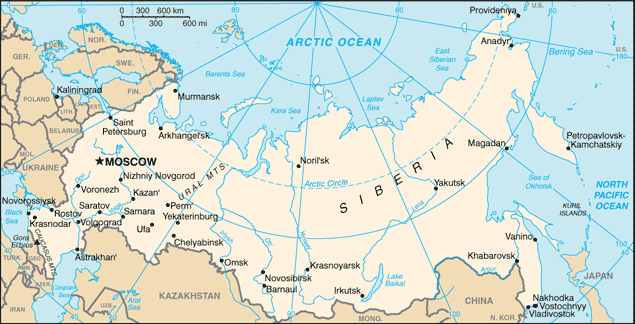Russia
 Russia is country of Europe located in north Europe - partly in Asia.
Russia is country of Europe located in north Europe - partly in Asia.
Details
| Official Name: | Russian Federation |
| Capital: | Moscow |
| Total area: | 17 098 242 km2 |
| GDP per capita: | $23,549 |
| Native Language: | Russian |
| Government: | Federal semi-presidential constitutional republic |
| Population: | 143,400,000 |
| Major Religion: | Orthodox Christianity |
| Monetary Unit: | Russian ruble (RUB) |
Russia, also officially known as the Russian Federation, is a country in northern Eurasia. It is a federal semi-presidential republic, comprising 83 federal subjects. From northwest to southeast, Russia shares land borders with Norway, Finland, Estonia, Latvia, Lithuania and Poland (both with Kaliningrad Oblast), Belarus, Ukraine, Georgia, Azerbaijan, Kazakhstan, China, Mongolia, and North Korea. It shares maritime borders with Japan by the Sea of Okhotsk, and the US state of Alaska across the Bering Strait. At 17,075,400 square kilometres (6,592,800 sq mi), Russia is the largest country in the world, covering more than one-eighth of the Earth's inhabited land area. Russia is also the world's ninth most populous nation with 143 million people as of 2012. Extending across the whole of northern Asia, Russia spans nine time zones and incorporates a wide range of environments and landforms.
Economy
Russia has a market economy with enormous natural resources, particularly oil and natural gas. It has the 8th largest economy in the world by nominal GDP and the 6th largest by purchasing power parity (PPP). Since the turn of the 21st century, higher domestic consumption and greater political stability have bolstered economic growth in Russia. The country ended 2008 with its ninth straight year of growth, averaging 7% annually between 2000 and 2008. Real GDP per capita, PPP (current international $) was 19,840 in 2010. Growth was primarily driven by non-traded services and goods for the domestic market, as opposed to oil or mineral extraction and exports. The average nominal salary in Russia was $640 per month in early 2008, up from $80 in 2000. In the end of 2011 the average nominal monthly wages reached 24,310 RUR (or US$810), while tax on the income of individuals is payable at the rate of 13% on most incomes. Approximately 13.7% of Russians lived below the national poverty line in 2010, significantly down from 40% in 1998 at the worst point of the post-Soviet collapse. Unemployment in Russia was at 6% in 2007, down from about 12.4% in 1999. The middle class has grown from just 8 million persons in 2000 to 55 million persons in 2006. Sugar imports reportedly dropped 82% between 2012–2013.
Oil, natural gas, metals, and timber account for more than 80% of Russian exports abroad. Since 2003, the exports of natural resources started decreasing in economic importance as the internal market strengthened considerably. Despite higher energy prices, oil and gas only contribute to 5.7% of Russia's GDP and the government predicts this will be 3.7% by 2011. Oil export earnings allowed Russia to increase its foreign reserves from $12 billion in 1999 to $597.3 billion on 1 August 2008, the third largest foreign exchange reserves in the world. The macroeconomic policy under Finance Minister Alexei Kudrin was prudent and sound, with excess income being stored in the Stabilization Fund of Russia. In 2006, Russia repaid most of its formerly massive debts, leaving it with one of the lowest foreign debts among major economies. The Stabilization Fund helped Russia to come out out of the global financial crisis in a much better state than many experts had expected.
Immigration and residency
If you are interested in moving to the countries, either with a residence permit or by acquiring a citizenship, please contact us, and also get acquainted with the relevant migration documents.